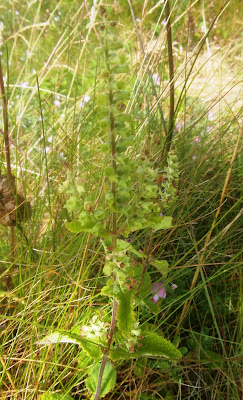On Sunday, we went to Oxwich on the Gower, There were signs of the recent heat-wave but Marsh helleborine (Epipactis palustris), Rest-harrow (Ononis repens), Sea holly (Eryngium maritima), Wood sage (Teucrium scorodonia), Wild thyme (Thymus serpyllum) and Pignut (Conopodium majus) were much in evidence, many attracting insects. The Stone bramble (Rubus saxatilis) fruit was much riper than the Bramble equivalent. There were masses of Common field grasshopper (Chorthippus brunneus), Small blue butterflies (Cupido minimus) and Small skipper (Thymelicus flavus). Gatekeeper butterflies (Pyronia tithonus) were mating as were Six-spot burnet moths (Zygaena filipendulae) as the female emerged from her pupa. There were many Sloe bugs (Dolycoris baccarum) and umbellifers showed beetlemania, including Cteniopus sulphureus).
This blog may help people explore some of the 'hidden' issues involved in certain media treatments of environmental and scientific issues. Using personal digital images, it's also intended to emphasise seasonal (and other) changes in natural history of the Swansea (South Wales) area. The material should help participants in field-based modules and people generally interested in the natural world. The views are wholly those of the author.
Wednesday, 31 July 2013
Sunday, 28 July 2013
Burning Brighter?
There is an interesting newspaper story about local Nepalese being recruited to 'hunt' poachers of tigers in their Himalayan region (http://www.guardian.co.uk/environment/2013/jul/28/tigers-extinct-endangered-patrol-nepal?INTCMP=SRCH). It is claimed that the action has led to a "small but encouraging rise in tiger numbers". The poachers, of course, are very heavily financially rewarded by selling tiger parts (especially the bones) for Chinese medicine and getting the locals to appreciate their 'star' conservation subjects can be an effective strategy. The presence of tigers might well increase tourism to the region. Given, however, experiences with other poached species (e.g. Elephant and Rhinoceros), one can't help but fear the poachers will ratchet up their 'game'. Their financial inducements might well increase.
Friday, 26 July 2013
Wednesday, 24 July 2013
There's No Business Like Snow Business
Fashion sometimes appears to claim victims indirectly. Apparently, the burgeoning fashion for cashmere wool has led to a great increase in goat numbers in the mountains of Asia. Their requirement for vegetation has decimated the numbers of antelope in the region (which, along with also suffering Yaks, need the food), resulting in marked declines in the already rare and highly secretive Snow leopard that would feed on them (http://www.guardian.co.uk/environment/2013/jul/23/snow-leopards-yaks-cashmere-gaots-fashion?INTCMP=SRCH). So a top predator falls prey to the pashmina!
Tuesday, 23 July 2013
Seeing the Changes 608
There were masses of Meadowsweet (Filipendula ulmaria) in Gorseinon. The Hazel (Corylus avellana) was producing nuts and the Field rose (Rosa arvensis), hips. Also got a nice shot of a Gatekeeper butterfly (Pyronia tithonus) there. In Bynea, Traveller's joy (Clematis vitalba) was in flower and Bramble (Rubus fruticosus) berries starting to ripen.
Monday, 22 July 2013
Swansea Bay- a Developer's Wet Dream?
Saturday, 20 July 2013
Fracking Stupid?
News that the UK Government is intent on trying to encourage shale gas production here, by offering 'massive' tax breaks, seems ill-advised. I can see the attractions of reduced energy costs and lowered dependency on imports of gas and oil but, I feel, we a) are crowded on to a small island, b) have many sensitive environments near the gas bearing rocks, c) don't really need to go for non-replaceable energy sources and d) need to get 'greenhouse gases' (methane as well as carbon dioxide) down.
Hot Stuff!
It seems that the prolonged hot spell in the UK has had a wide range of effects on wildlife. Natural history buffs has listed things that people can do to improve the survival chances of animals and plants (http://www.guardian.co.uk/environment/2013/jul/19/heatwaves-hot-weather-wildlife?INTCMP=SRCH). Some of this relates to attempting to limit the destructive effects of grass fires and preventing the drying of small ponds and streams but other suggestions include allowing wild plants to flourish for longer. Butterflies appear to be undergoing something of a recovery after a number of cool, wet 'summers', according to the annual butterfly count
(http://www.guardian.co.uk/environment/2013/jul/19/butterflies-obsessives-elusive-purple-emperor).
(http://www.guardian.co.uk/environment/2013/jul/19/butterflies-obsessives-elusive-purple-emperor).
Friday, 19 July 2013
Thursday, 18 July 2013
Tuesday, 16 July 2013
Seeing the Changes 603
The hot weather continues the natural history explosion! Lesser bulrush (Typha angustifolia) was out in Bynea. This was accompanied by the flowering of Marsh mallow (Althaea officinalis), Tree mallow (Lavatera arborea), Hemp agrimony (Eupatorium cannabinum), Common hogweed (Heracleum spondylium), Common sea lavender (Limonium vulgare), Common fleabane (Pulicaria dysenterica), Perennial sow-thistle (Sonchus arvensis), Vervain (Verbena officinalis) and Good King Henry (Chenopodium bonus-henricus). Insect-wise there, there were masses of Gatekeeper butterflies (Pyronia tithonus) and Soldier and sailor beetles (Rhagonycha fulva). In Loughor, a Silver 'Y' moth (Autographa gamma) flitted around the garden.
Subscribe to:
Comments (Atom)
-
I n the UK and US, a pparently popular and successful vegan/vegetarian restaurants are reportedly closing or adding meat to their menus ( ...
-
Early ripening fruit may seem convenient but some folk think it confirms environmental stress. There's also a possibility th...






+lateral+Oxwich.JPG)
+fruit+Oxwich.JPG)

+Oxwich.JPG)




+lateral.JPG)




+close+up+head.JPG)






















+North+Gower.jpg)

+lateral+on+bramble+Oxwich.jpg)











%20mating%20NWCW.jpg)

